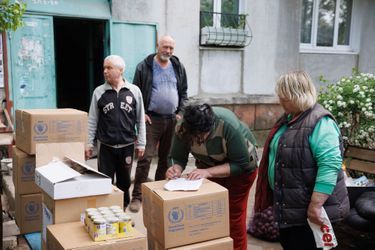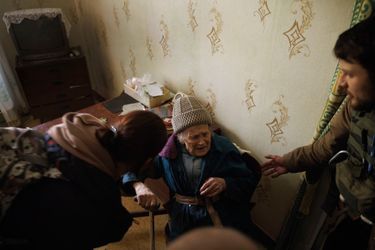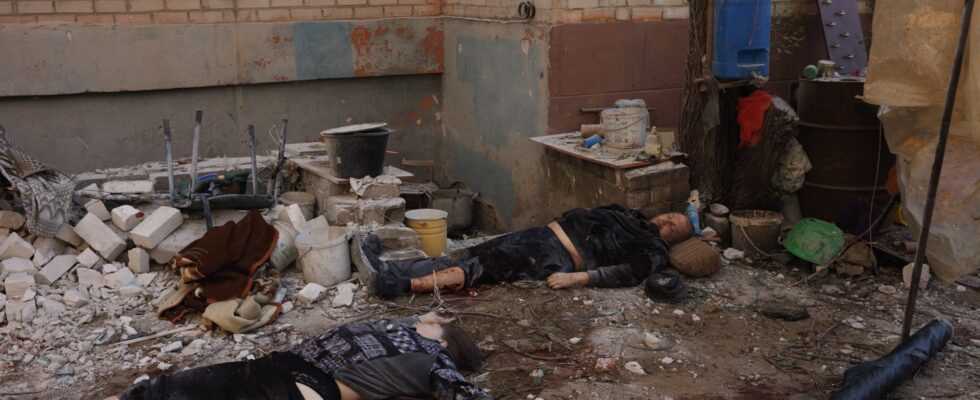Since the fall of Mariupol, it is on this city of Donbass that Putin’s army has been hounding: 4,000 daily shells.
It’s a thunder that never stops. It is part of the decor, all day and night, and only a variation in intensity reminds us to run for shelter. But sometimes it’s too late. Like at school no. 18. When the shell hit the floor, three people who were in the yard did not have time to reach the basements. They died where, a few days earlier, Valia, a talkative kid of about ten, proud of her gold earrings, had been filmed saying that life, of course, was difficult in Severodonetsk, but fun also, with all the other refugee children in the school…
Read also: Scholz “convinced” that Putin will not win the war in Ukraine
By showing the queue in front of the improvised barbecues which gave the playground the look of the end-of-year celebrations, she adopted the speech of an old philosopher: “Everything has a beginning and an end, and everything this will end soon. Things will go back to what they should be, everyone will find their place, no one will go where they shouldn’t go. So speaks a child of war.
Read also: A new life begins in Canada for Ukrainian refugees
What has become of Valia in this uninterrupted music announcing that the Russian gripper is closing in on Severodonetsk like the nutcracker on the hull? Matthias Bruggmann, a 44-year-old Swiss photographer, recorded the percussion noise that accompanies any outing in what is still the Ukrainian capital of Luhansk Oblast, just 30 kilometers from the (unrecognized) border of a self-proclaimed republic which claims the same name. He chose to follow a strange battalion, a heterogeneous body of civilians made up, among others, of the keyboardist of a punk band, his social worker companion, a supermarket employee, a pharmacist, a pensioner of the merchant navy and a taekwondo champion, accompanied by his sharpei dog.
“Real, pure”, he is moved. But the broke… They are equipped with old cars whose tires keep bursting on the scrap metal. And this is how, despite the bombs, and often under the bombs, they go door to door to bring food, convince a babushka who has lost her mind, a pregnant woman frightened at the idea to give birth on the road, that it is time to leave, that there is no place for anyone here, no more for the old, the poor, the sick, than for the stubborn or the unconscious… “The Donbass is hell! announced President Zelensky. Whether they feel Ukrainian or even Russian, all the inhabitants of Severodonetsk are treated equally under a deluge of 4,000 daily shells. Will the grass grow back where Vladimir Putin’s armies have gone?
On May 20, one of the injured from school n°18. The main losses, the Ukrainians do not suffer them in battle, but among civilians.
© MATTHIAS BRUGGMANN
It seems that nothing changes in these latitudes. Here lived the Zaporozhian Cossacks for a long time, these warrior peasants who elected their leader every year. Nothing distinguished him except the height of his cap. And when the campaign was announced, most often against the Tartars, no gendarme needed to sound the call. Three or four centuries after their disappearance, Arthur Quesnay, a doctor of political science on his return from the Donbass, co-author of a column published in “Le Monde” on the urgency of the aid to be provided, is still amazed by the effectiveness of this “horizontal organization”. He certainly notes the surprising power of resilience of the state, never K.-O. despite the violence of the blows: “The police, the fire brigade, all of this continues to function. But what amazes him the most is the mobilization of these networks, structured by the municipalities. Next to it, the big NGOs, “under the umbrella of the UN”, look like big cockchafers weighed down by their administration.
Only the poorest, the oldest, the sickest remained. They must survive in a city returned to the Stone Age
In February, a week before the start of hostilities, they evacuated their doctors, their humanitarians, from the zone declared red. In imposing convoys, they sped towards Lviv, where, of course, there is no shortage of work with refugees and displaced persons, but where we are more than 1,000 kilometers from the martyred Donbass… ‘has been established. In offices as if emptied by a gust of wind, there are still, in addition to computers, boxes of condoms, memories of a time when the fight against AIDS was considered a priority. A goldfish, forgotten in its bowl, turns in circles, the only presence still alive. All international aid has disappeared. Remains an evangelical church. And especially the municipal team and the National Red Cross, who rely on men and women “of good will”, without acronyms or means, without salary, to organize evacuations, the arrival of food, its distribution , the only way to survive in front of barricaded shops, emptied stocks. They distribute the flashlights, the rare medicines recovered from the ruins of a pharmacy.

Signing a receipt after delivery of World Food Program parcels.
© MATTHIAS BRUGGMANN
Philip coordinates the logistics, he is a former philosophy student who went through Prolieska, a national NGO. Sometimes we see him photographing. It’s not just to feed the @humhub_severodon instagram account, but because it needs supporting documents. In the absence of receipts, of stamped notes, he sends photos telling himself that, during the war at least, there would be more need for psychologists than accountants… Thanks to them, he might succeed in convincing the last reluctant to choose the exodus and, if he had an old armored truck, like those of transport of funds for example, it would be even better.
Severodonetsk, 100,000 inhabitants before the war, would be a new Mariupol for the Russians. Russian-speaking city, torn from their appetite in 2014 by the Aïdar battalion, another band of “Nazis and drug addicts” recruited among the demonstrators of the Maidan, in kyiv, which, at the cost of a hundred deaths, had swung Ukraine on the side of Europe and democracy. Severodonetsk also humiliated them.
A “sleeping” industrial age palace. Everything is frozen there
As an Azovstal factory, the Russians will find Azot there, a huge chemical factory with its fallout shelters which still serve as a refuge. She is the jewel of the kingdom of Dmytro Firtache, one of the richest men in Ukraine, who no longer knows what to do to prove that he is not, or is no longer, Putin’s vassal. From Austria, where he is a refugee, hoping to escape the American extradition request launched “due to an indictment based on allegations of a corruption scheme which he categorically denies” (press release from his lawyers, among which a certain Rudy Giuliani, former mayor of New York and close to Donald Trump), Firtache published in January a column summarizing this question: “Why can’t Ukraine be the Switzerland of Eurasia? A month later, he had his answer and took a stand against a “gratuitous and unjustified” invasion. Isn’t he afraid of falling victim to the epidemic fatal to so many oligarchs? He replies: “It’s hard to say, but I have no choice. »
Some have claimed that the explosion of a factory like his, loaded with ammonia, could have the same effect as that of the port of Beirut. Management hastened to contradict them, announcing that all danger had been averted, that production was stopped and hazardous products recycled or evacuated. The gigantic chimneys that dominate the Boulevard des Chimistes are a bit like the Eiffel Tower, a reminder of past grandeur when, in a nearby mine a few kilometers away, a certain Stakhanov invented the glory of the worker through performance.

Volunteers Philip and Masha try to convince an elderly lady to follow them. Because of a bombardment, it no longer has glass in its windows.
© MATTHIAS BRUGGMANN
Nitrogen fertilizers, made from natural gas, have formed, together with wheat and sunflower, the wealth of Ukraine. Now, their price, indexed to that of gas, soars until the markets tremble, casting doubt on the results of the 2023 harvests, while the planet is increasingly hungry.
In the deserted streets, one sometimes sees a man, climbed in a tree. He is sawing off a branch. No other way to make a fire. The courage of the municipal employees who persisted in repairing the severed lines, the exploded pipes, changed nothing: the city returned to the Stone Age. We dream of the old toxic fumes as of a time when we could eat our fill, bury our dead elsewhere than in mass graves.
Before the start of the war, which we cannot forget that here it began in 2014, the Luhansk oblast had more than 40 metallurgical enterprises, there they produced railway cars, the tunnels of the gas pipeline that connects Russia to Germany, it produced 3.7% of Ukraine’s wealth, while the entire Donbass produced 11%. As in a palace of the industrial era “in the sleeping wood”, everything is now fixed. Except ghosts. It even seems as if the din of the artillery wakes them up. Those of the peasants whose death from starvation was part of Stalin’s great five-year plan, those of the soldiers of the Red Army caught between the bullets of the German invader and those of the political commissars who forbade them to retreat.
The writer Vasily Grossman heard them shout: “Miners, forward! Miners don’t back down! One night in February 1942, very close to here, he noted in his war diaries: “In a field, our soldiers spotted three German machine gunners near haystacks. They surrounded them, then they shouted: “Surrender!” The Germans kept silent. In fact, there they were, standing there frozen to death… Apparently they had been planted by pranksters. After the war, the vanquished will rebuild Severodonetsk, which Putin’s generals are now working to destroy, as if the lands of Donbass continued to belong to those “lands of blood” described by historian Timothy Snyder. The clear waters of the Donets River hide their game well. Kharkiv, Izioum, Roubizhne, Lyssytchansk, Severodonetsk… So many stopovers, so many ruins. The Donbass Stations of the Cross.
To donate to groups of volunteers present in Donbass: Vostok-sos.org/en .
Danièle Georget is co-author of the “Lover’s Dictionary of Ukraine”, ed. Plon, 432 pages, 24 euros.
